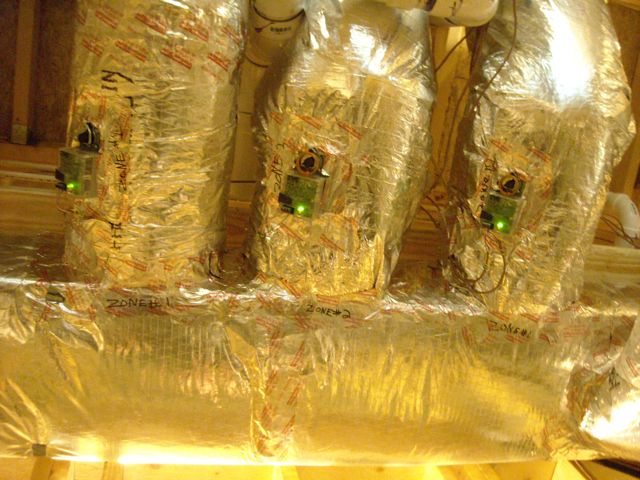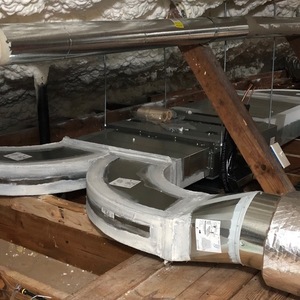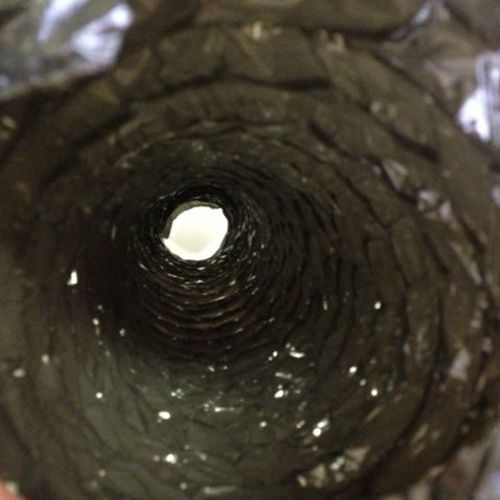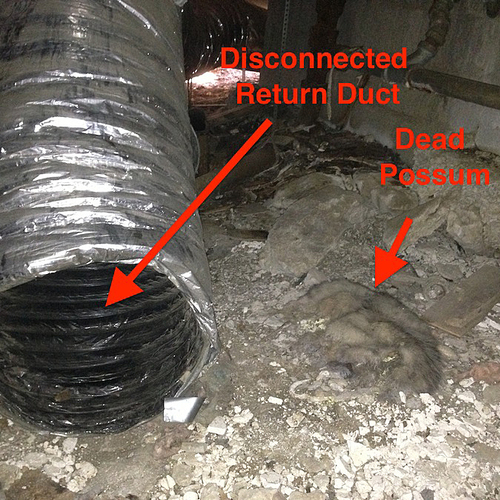Image Credit: Energy Vanguard
Image Credit: Energy Vanguard In a zoned duct system, the bypass air mixes with the return air, cooling it before it goes across the air conditioner's evaporator coil. The cooler entering air reduces the efficiency of the system.
Image Credit: Energy Vanguard A zoned system bypass duct is usually easy to spot. Just look for a duct that goes straight from one side of the air handler to the other, as you see in this photo.
Image Credit: Energy Vanguard
Last week I wrote about what happens when you try to save energy by closing air conditioning registers in unused rooms. In the end, I recommended not doing it because you won’t save money and you may create some big problems for yourself, like freezing up the coil and killing your compressor.
At the end of the article, I mentioned that zoned duct systems do close off registers, and that doing so can be OK with the right kind of equipment and design. But there’s one thing often done in zoned duct systems that’s rarely done well.
Weekly Newsletter
Get building science and energy efficiency advice, plus special offers, in your inbox.
What is zoning?
Before we find out what that thing is, though, let’s be precise in our language and clear up exactly what we’re talking about. The word “zoning” is used in more than one way in the context of heating and air conditioning systems in a house. First, larger houses are almost always zoned. That is, they have more than one thermostat so you can control the conditions separately in different parts of the house. In a two-story house, for example, there will probably be at least two thermostats — one upstairs and one downstairs.
The other way that the term “zoning” is used is to describe a single duct system attached to a single HVAC system that serves multiple zones. In most homes with forced-air HVAC systems, each thermostat is connected to its own heating and cooling system. The home is zoned, but the HVAC system is not. In a “zoned system,” a single heating and air conditioning system is controlled by multiple thermostats in multiple zones.
In the photo above, the three green lights are part of three zone dampers that control the flow of air to three separate zones. Depending on the needs of the house, any combination of one, two, or three zone dampers may be open and sending conditioned air to their respective zones.
If only one or two of the zones are calling for air, most air handlers will create extra static pressure because one or two of the pathways are closed off. Enter the bypass duct (shown in Image #2, below). When the system is running but not all of the zone dampers are open, the bypass duct — in theory — is supposed to relieve the extra pressure and maintain good air flow throughout the duct system.
The problems with the bypass duct
A few years ago at the ACI conference, I heard John Proctor and Rick Chitwood discuss the issue of bypass ducts. Proctor isn’t a fan of zoning at all, and Chitwood is. On one point, though, they both agreed: Bypass ducts should never be used.
Here are three reasons why:
- Throwing cold air directly into the return plenum reduces the temperature of the air coming in to be cooled. That makes the evaporator coil get colder, and the colder it gets, the less efficient it becomes.
- The bypass duct steals air. Even with all three zone dampers open, the bypass duct has a big pressure difference across it, and air is lazy. It’ll cheat and take the path of least resistance whenever possible, in this case the bypass duct.
- Not only is a colder evaporator coil less efficient, it’s also more likely to freeze up, as the condensation it collects eventually drops below the freezing point. (And if you think a bypass duct is bad for air flow, a frozen coil is way worse. It’s really hard to push air through a solid block of ice.)
Savings from eliminating the bypass
Just this week, Proctor posted an article on zoning and bypass ducts on his website. With the article, he included a video demonstration of a zoned system, showing the changes in airflow and temperatures with and without the bypass duct open.
Then he performed the calculations to show the efficiency for each configuration. In his little experiment, the three configurations with the bypass duct closed (with no air through bypass) were 22%, 27%, and 32% more efficient than the configuration with the bypass duct open.
Of course, if you’re sending air to only one zone, you still have the issues of reduced air flow in a PSC blower and increased energy with an ECM blower, as I described last week for the register-closing scenario. To do zoning right, you’ve got to account for the extra air when one or more zones are closed during operation. Probably the best way to do that is with a multi-stage air conditioner that can also ramp down the fan speed to send less total air through the system.
My friend David Butler, one of the most accomplished HVAC designers I know, believes that bypass ducts can be done right… but it’s still best to avoid them. “It’s a tool that should only be used when [other] options aren’t feasible or possible.” The bottom line with zoning is that it’s a tricky business no matter which way you go. ACCA has a zoning protocol called Manual Zr, and that’s a good place to start if you’re going to design a zoned system.
Allison Bailes of Decatur, Georgia, is a speaker, writer, energy consultant, RESNET-certified trainer, and the author of the Energy Vanguard Blog. Check out his in-depth course, Mastering Building Science at Heatspring Learning Institute, and follow him on Twitter at @EnergyVanguard.
















6 Comments
It's 2014. Why aren't there
It's 2014. Why aren't there factory engineered zoned systems???????
Really makes no sense for any HVAC manufacturer not to have sets of standard installs for them to put in manuals and have training for HVAC "pros."
HVAC pros are rare. I do much of it myself these days.
Allison, you need to get with your HVAC entire trade group and get your folks to the 21st century.
Our zoning rules for heat pumps
1) No bypass, ever.If a proposed system looks to need a bypass, redesign it so that it doesn't. If that can't be done don't bid or build it. Let someone else die taking that hill.
2) Zone only multi-stage systems. If the client has the wallet for zoning, they need to spring for at least a two stage system. A reluctant exception is occasionally made - smaller single stage system may be split into two approximately equal sized zones if the ductwork can be oversized to accommodate and client accepts that non-calling zone will experience SOME airflow.
3) No crappy two wire power open spring closed dampers - commercial grade 3 wire dampers ONLY.
4) No compressor overrides using discharge air temperature sensors. (DATS no good!) They beat heck out of compressors and kill efficiency.A popular zoning components vendor includes these in their kits, and we have a collection of them back in the office. Handy source of thermistors...
5) Strive to ensure ducts are all in conditioned space. That's gospel here anyway, but it is especially important with zoned systems done per our rules because of extra and oversized ductwork. If all that is in unconditioned space, losses will be substantial.
Zoning works - we routinely configure 3 zone systems based on medium SEER two stage systems. Typical arrangement is 1) Master suite 2) Main "daytime" or "public" rooms 3) kids bedroom wing or similar grouping. Done right, the big #2 zone can accommodate system's entire high stage air flow, allowing system's entire capacity to be available to meet extra load from parties or intense cooking.
PS - if you think a bypass raises Cain in cooling...consider also heating impact - recycling warmed air back into return greatly increases coil temperature, refrigerant pressure and compressor load, killing efficiency and longevity. That's stupid, so don't do it! The DATS crowd will say they control that, but frequent compressor restarts are arguably worse in heating than in cooling owing to higher compressor loads.
For interested pros, an in-depth discussion on zoning design...
Rather than repeating a lot of stuff here and having to monitor and respond to multiple threads on the same topic, I refer pros interested in zoning design to an ongoing discussion in the LinkedIn "RESNET BPI - Energy Audit and Home Performance" group: zone control design discussion (requires membership)
Good Zoning Systems do exist
There are factory engineered zoning systems that do exist, I have one in my house I built @ 5 years ago. I installed a Bryant Evolution system, it works without a bypass damper. The most important thing to do to maximize system efficiency is to size your ductwork properly for each zone.
I have a 2150 sq ft. house in Texas, ICF construction, so all I needed is a 2 ton unit. The unit is a 2 stage heat pump, so low speed operates at @ 1 ton. Since the air handling unit is a variable speed it goes down to 250 cfm per ton. So all I did was make sure that each of my 4 zones are sized to accomodate at least 250 cfm, I actually sized them to handle @ 350 cfm per zone.
The Evolution control system is one of the best zoning systems on the market, as it operates without a bypass damper. If a zone that is calling for cooling or heating can't deliver the necessary minimum cfm the system needs to operate, it evaluates the rest of the zones and opens the zone that is farthest away from setpoint only enough to deliver the remaining cfm necessary for proper unit operation.
Factory designed systems do exist that work very well and don't cause equipment problems.
Response to Eddie Qualls
You've identified some of the most important qualities of a properly zoned system. Curt Kinder gave a good list above, too, but basically, you need a way to reduce the capacity and the air flow when not all zones are calling for air. Designing your system so that each zone can move the minimum air flow is the way to go, not bypass ducts.
I assume you're on the humid side of Texas since you're moving the air so slowly, but 250 cfm/ton sounds too low to me. Do you know how often your system runs at that speed? It'd be good for the swing seasons when you don't have as much cooling load, but I hope in summer you're running closer to 350 cfm/ton.
balance
If you zone the supply ducts and don't zone the returns, then you are depressurizing closed door rooms. This pulls air through the exterior walls, a bad idea for several reasons.
In most cases, zone dampers don't need to close all the way - think of zoning as an adjustment, not a on/off thing. This helps with the minimum air flow issue.
Log in or create an account to post a comment.
Sign up Log in